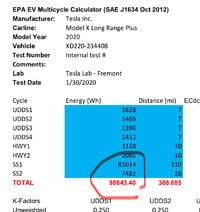anyways. Here are the pictures of data I provided before (had to sensor the reflection/map).
View attachment 1060500
I put in the numbers for that X. We do not know much about daily charges, garage etc. so I used 25C average cell temp, which is probable if it has been outside and also 80% daily charge and 60% end of the day:
Not very far away, considering we do not have the complete picture and using the most common charging schedule.
(Might be good to know that i did suppress the higher degradation at 80% slightly and also increased the degradation at 100% slightly in the formulas to have a sloping plane downwards towards 100%. I have a plan to make a site very you can check the prognose of your car, depending on the charging habits. It would be a white lie, making sure people doesn’t start to charge to 100% based on the data I give them.
IRL the degradation should be slightly higher for the “80:iers” then in my formulas.)
also I did edit my previous post with more questions
 Battery health tracking SS
Battery health tracking SS while you were typing up your response.
Although I do still think that environmental variables have impact on car batteries (weather cycles, driving styles, charging speeds etc).... and cant be completely discounted. Stuff that lab cant replicate.
It would be practically impossible to cover all aspects of degradation/cyclic aging in the posts to you, but it already is covered in the hundreds of post I already made here on TMC, so the data is here.
Basically, if you ask me, the reserachers most often use too high charging and discharing current compared to a EV use.
This means many of the charts has been with 1C (about 78kW charging discharging with an 3/Y LR/P.)
This equals the middle part of a supercharging for the charge part and it also equals driving around 200kph/125 mph on the highway from start to stop of all discharges. ( the charts above was like that).
Luckily enough, there are tests with different charging rates as well.
This is a Panasonic 18650 with a the same
Chemistry as Tesla use.
(This is bit the only one showing this, so we have several examples showing the same)
The cell is 2.9Ah so thre three different charging rates showing the same degradation is 0.17C, 0.24C and 0.34C
These represent 13kW, 19kW and 27kW charing power. The degradation is the same despite different charging power. This means all AC Charging causes about the same degradation.
For driving, normal highway driving will be about 0.25-0.3C (a full charge will take 4 to 3 hours to discharge).
Most of the tests show around the same degradation rates up to 2C, (160kW alla the time from 100% to 0%) so normal use will cause about the same degradation.
Maybe-probably slow driving around the town reduce this slightly. But on the other hand a slight difference is in a low value would be not noticable.
There are differences in cyclic aging depending on temperature, not very big though for Panasonic NCA but they are already covered in the formulas by the average temp of the pack.
Thunderstorms and rainy Days doesnt make any difference except if the lightning or water goes into the pack

So the rest of the weather the pack is happily not knowing about.
All the things that actually make a noticable
difference in degradation is found in the research and is reflected in my formulas.
I havent incorporated very hard track driving, that will make a difference if it is performed very often. It would be hard
to judge the extent of it even if the data about how a high power acceleration ( = discharge) degrades the battery.
For occasional high power driving or supercharging there is a recovery effect of the cells, making them “self repair capacity” that has been noticed during the research. So for the average Tesla owner we doesnt need to count full power pulls
or supercharging sessions.
( I have around 18% supercharging on both on my ex M3P and the MSP, and I sure used the power qiute hard from time to time. O
See a Slight lowering of the capacity afterwards extensive power use or several supercharging sessions but it always climb back after anwhile of nice low cycles. This is the same om
Both cars.)




